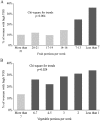The effect of obesity and dietary habits on oxidative stress in Hashimoto’s thyroiditis
- PMID: 30300538
- PMCID: PMC6176279
- DOI: 10.1530/EC-18-0272
The effect of obesity and dietary habits on oxidative stress in Hashimoto’s thyroiditis
Abstract
Objective: Increased oxidative stress has been described in patients with Hashimoto’s thyroiditis (HT). The aim of the present study was to investigate whether high oxidative stress is further influenced by obesity and dietary habits in euthyroid women with HT.
Methods: Two hundred eighteen consecutive euthyroid women with HT were studied and separated in two groups; 102 with thyroxine replacement and 114 without. For the evaluation of oxidative stress, total lipid peroxide levels in serum (TOS) were measured and recoded as ‘high TOS’ vs ‘medium/low TOS’. The type of food and consumption frequency were recorded. Two binary variables were considered; normal vs low fruit consumption and daily vs sporadic vegetable consumption.
Results: ‘High TOS’ was more frequent in women under thyroxine replacement (31.4% vs 14.7%, OR = 2.7, 95% CI: 1.4–5.2). The prevalence of ‘high TOS’ was higher among overweight/obese women compared to women with normal BMI (30.4% vs 12.5%, OR = 3.1, 95% CI: 1.5–6.4). Low fruit consumption was associated with increased ‘high TOS’ prevalence (30.6% vs 12.9%, OR = 3.0, 95% CI: 1.4–6.2). Sporadic vegetable consumption was associated with increased ‘high TOS’ prevalence compared to daily consumption (29.9% vs 13.5%, OR = 2.7, 95% CI: 1.3–5.7). The examined risk factors were independent and additive in their effect on TOS. At least three risk factors had to be concomitantly present for the likelihood of ‘high TOS’ to be significantly elevated.
Conclusions: Oxidative stress is increased in women with HT under thyroxine replacement. Nevertheless, normal BMI, daily fruit and vegetable consumption, all contribute in maintaining oxidative stress at low levels.
Keywords: oxidative stress; Hashimoto’s thyroiditis; obesity; dietary habits.
© 2018 The authors
Figures



Similar articles
-
RAGE polymorphisms and oxidative stress levels in Hashimoto's thyroiditis.Eur J Clin Invest. 2017 May;47(5):341-347. doi: 10.1111/eci.12739. Epub 2017 Mar 20. Eur J Clin Invest. 2017. PMID: 28226412
-
Assessment of visualization of structures in the middle ear via Tos modified canal wall-up mastoidectomy versus classic canal wall-up and canal wall-down mastoidectomies.Int J Pediatr Otorhinolaryngol. 2007 Jun;71(6):851-6. doi: 10.1016/j.ijporl.2007.02.004. Epub 2007 Mar 21. Int J Pediatr Otorhinolaryngol. 2007. PMID: 17368815
-
The impact of levothyroxine sodium treatment on oxidative stress in Hashimoto's thyroiditis.Eur J Endocrinol. 2016 Jun;174(6):727-34. doi: 10.1530/EJE-15-1061. Epub 2016 Mar 7. Eur J Endocrinol. 2016. PMID: 26951600
-
Multiple Nutritional Factors and the Risk of Hashimoto's Thyroiditis.Thyroid. 2017 May;27(5):597-610. doi: 10.1089/thy.2016.0635. Epub 2017 Apr 6. Thyroid. 2017. PMID: 28290237 Review.
-
Coexistent Hashimoto's thyroiditis with papillary thyroid carcinoma: impact on presentation, management, and outcome.Surgery. 1999 Dec;126(6):1070-6; discussion 1076-7. doi: 10.1067/msy.2099.101431. Surgery. 1999. PMID: 10598190
Cited by
-
Subclinical Hypothyroidism in Patients with Obesity and Metabolic Syndrome: A Narrative Review.Nutrients. 2023 Dec 27;16(1):87. doi: 10.3390/nu16010087. Nutrients. 2023. PMID: 38201918 Free PMC article. Review.
-
Metabolic Characteristics of Hashimoto's Thyroiditis Patients and the Role of Microelements and Diet in the Disease Management-An Overview.Int J Mol Sci. 2022 Jun 13;23(12):6580. doi: 10.3390/ijms23126580. Int J Mol Sci. 2022. PMID: 35743024 Free PMC article. Review.
-
Dietary Patterns and Hypothyroidism in U.S. Adult Population.Nutrients. 2024 Jan 28;16(3):382. doi: 10.3390/nu16030382. Nutrients. 2024. PMID: 38337667 Free PMC article.
-
Association of MTNR1B Gene Polymorphisms with Body Mass Index in Hashimoto's Thyroiditis.Int J Mol Sci. 2025 Apr 12;26(8):3667. doi: 10.3390/ijms26083667. Int J Mol Sci. 2025. PMID: 40332199 Free PMC article.
-
Low Serum Fibroblast Growth Factor 21 Level and Its Altered Regulation by Thyroid Hormones in Patients with Hashimoto's Thyroiditis on Levothyroxine Substitution.Metabolites. 2024 Oct 21;14(10):565. doi: 10.3390/metabo14100565. Metabolites. 2024. PMID: 39452947 Free PMC article.
References
LinkOut - more resources
Full Text Sources
Molecular Biology Databases

